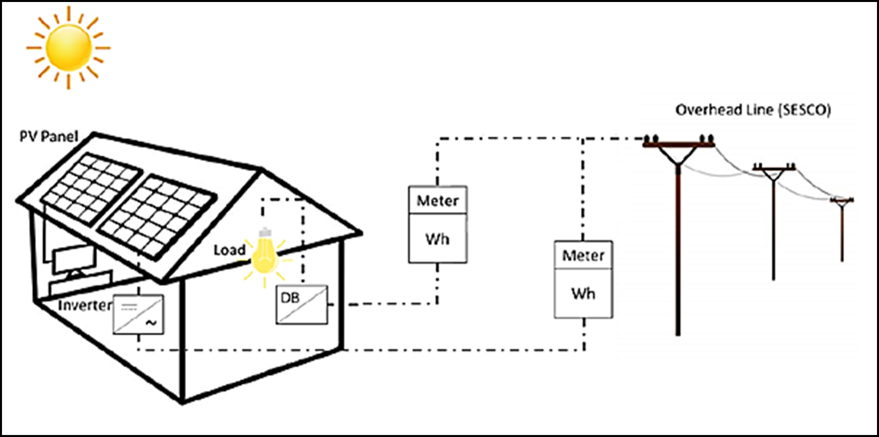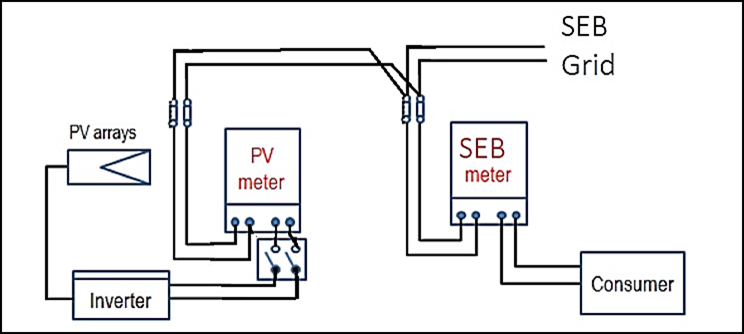

NET ENERGY METERING SCHEME
Introduction
Net Energy Metering (NEM) scheme is a billing mechanism that credits direct Solar Photovoltaic (PV) system owners for the electricity they add to the grid. For example, if a residential consumer has a PV system on the rooftop, it may generate more electricity than the home uses during daylight hours. Rolling out of NEM scheme in Sarawak is to promote the use of renewable energy and the conservation of non-renewable energy at the consumer level.
-
Eligibility Criteria
- Open to all tariff categories where applicants are connected to the Sarawak Energy Grid System.
- Applicant with outstanding bills of more than two months and/or pending meter tampering case are not eligible for the scheme.
- The resource for electricity production shall be from Solar PV only without any form of energy storage i.e., battery connected to the system
-
Solar PV System for NEM
- Capacity Limit
- 10kWac for Single Phase
- 30kWac for 3 Phase (Systems with a capacity above 30kWac require a power system study)
- Subject to quota availability (Not more than 75% of the total maximum transformer loading in the area from 11hrs to 1500hrs.
- Applicants shall install the solar PV system with the capacity that generates energy not exceeding 75% of the average consumption for the past 3 months.
- For systems exceeding 30kWac, a power system study is mandatory. For systems above 50kWac, the applicant shall seek consultation and undertake negotiations with Sarawak Energy’s Single Buyer.
- Types if Installation Allowed:
- PV modules can only be installed at the following locations:
- On the rooftop of building, and
- On the garage, car park, and similar structures
For types of installation other than mentioned, the applicant shall seek approval from the Director of Electricity Supply, Sarawak.
- PV modules can only be installed at the following locations:
- Connection
PV Systems shall be connected to Sarawak Energy Distribution Network in accordance with the following requirements:
- Voltage:
- Single Phase 240V (+5% and -10%)
- 3 Phase 415V (+5% -10%))
- Voltage Fluctuation:
The maximum voltage fluctuation range allowed due to varying solar radiation is 6%. Beyond this, the utility and consumer equipment will be at risk of overheating.
- Power Factor:
PV Systems shall have a leading or lagging power factor greater than 0.9 and 0.85 respectively when the output is greater than 20% of the rated output power.
- Power Quality:
- Harmonics shall comply with the emission limits set out in Engineering Recommendation G5/5.
- Voltage unbalance shall comply with the emission limits set out in Engineering Recommendation P29.
- Flicker shall comply with the emission limits set out in Engineering Recommendation P28.
- Voltage:
- LV Penetration Level for Multiple Installations:
Multiple installations of PV in a same LV network will increase the current injection to the respective network. Undesirable overvoltage in the LV networks might occur if the magnitude of PV current injection is greater than the load of the LV networks.
Recommendation for PV penetration limits are as follows:
- Maximum allowable Solar PV capacity connected to a single LV feeder is 25kW. This is to ensure that, under worst case scenario without load, the voltage limit of 240V (+5% and -10%) will not be violated.
- Maximum allowable solar capacity connected to LV feeder pillars is 75% of the local transformer loading.
- Interconnection Method
The Interconnection to Sarawak Energy Distribution Grid System shall be done through Direct Connection. Figure 1 shows the diagram of direct connection between the Prosumer’s Solar PV system and the Grid System.
- The Connection shall be made in accordance with MS IEC 1837 and its updated versions.

Figure 1: The Direct Feed NEM Approach
- Metering Scheme
- A meter shall be installed to measure the energy export of the PV system to Sarawak Energy system. This shall be achieved via a dedicated energy meter (PV Meter) installed at the output of the PV system.
- PV Meter shall be installed as near as possible to Sarawak Energy Meter with maximum distance of 1 meter apart and properly labelled as “PV METER”.
- PV Meter connection to the Grid System shall be done via the existing meter cut-out and neutral link. This point shall be identified as the Common Connection Point (CCP).
- The customer shall be responsible for any installations after the meter.
- The Contractor shall provide and install all the materials required for the system interconnection works.
- All live connection and meter installation works shall be carried out by the authorised Sarawak Energy personnel only.
- For looping connection between cut-outs, 16mm2 Cu cable should be used if the meter is installed in separate cabinets (with maximum distance of 1 meter).
- The PV smart meter must be of the same type as Sarawak Energy’s existing smart meter. For example, a three-phase household must be paired with a three-phase solar PV system.
- Existing Sarawak Energy normal meter shall be replaced by the smart meter.
- The connection of PV Meter is shown in Figure 2.

Figure 2: Connection Diagram for PV Meter and the Consumption (Sarawak Energy) Meter
- Capacity Limit
-
Solar PV System Component and Equipment Requirements
NEM Contractors are responsible for carrying out necessary due diligence on the connection point to facilitate connection of generated energy. All component and equipment that are to be used and installed for the NEM scheme must comply with the latest specification approved for use in the system according to the latest version of MS1837: Installation of grid-connected photovoltaic (PV) system (refer Normative Technical Reference List).
-
NEM Application Process
- All NEM applications shall be submitted by the appointed Sarawak Energy Registered Contractor on behalf of their client to Sarawak Energy’s Customer Service Counter.
- Application Documents Needed:
- Forms:
- NEM Application Form = NEM Application Form for Below 30kWac
- AC01 Form = PV Meter Application
- Supporting Documents:
- Letter of Appointment for Contractor
- Overall Layout, Location Plan and Front View Photo of the Premises
- Consent Letter from the Building/House Owner for the Installation of the Solar PV System (applicable only for rented GCPV installation sites or rental properties)
- Copy of Chargeman L4 Certificate
- Copy of EIU Certified GCPV Designer Certificate or EIU Authorised GCPV Designer Certificate
- Copy of EIU Certified Electrical Supervisor (Substation) Certificate, or Competent Electrical Engineer (CEE) Certificate, or PEPC
- Information on the past three (3) months’ consumption (based on billing)
- Inverter Specification
- Electrical Drawing with Interconnection Point endorsed by:
- AC Circuit: Electrical Supervisor (Substation) for systems up to 100A
- AC Circuit: Competent Electrical Engineer (CEE) or PEPC for systems above 100A
- DC Circuit: EIU Certified or Authorised GCPV Designer
- Estimated Monthly Energy Generation
- Forms:
- NEM Application Workflow:

- All NEM applications shall be submitted by the appointed Sarawak Energy Registered Contractor on behalf of their client to Sarawak Energy’s Customer Service Counter.
-
Testing & Commissioning
Testing & Commissioning (T&C) shall be performed by the appointed Contractor. T&C Report shall be submitted to Sarawak Energy Customer Service Counter for the issuance of NEM Contract, and PV Meter Fee.
For new individual houses or housing developments, the internal wiring test must be completed and passed prior to conducting the testing and commissioning (T&C) of the solar PV system.
-
NEM Contract
Contract for Supply of Electricity (for Solar Photovoltaic Installation Under Net Energy Metering Scheme) shall be issued to and signed by the applicant prior to PV Meter Installation and system commissioning. Refer to 3.2 of MOU Guidelines.
-
Connection Charges
All PV metering cost shall be borne by the NEM Customer. The unit price of smart meters for NEM are as follows:
- Single phase smart meter: RM 500
- Three phase smart meter: RM 1000
All other connection charges shall be borne by the NEM customer.
-
NEM Contractor
All NEM applications shall be submitted by the appointed Sarawak Energy Registered Contractor (Contractor) on behalf of their client. The Contractor shall engage the following competent persons for the design, installation, and testing & commissioning of the PV system:
- Internal Wiring: Certified Wiremen (EIU); Certified Authorised to Test (ATT) (EIU)
- PV Designer: EIU Certified GCPV Designer Certificate or EIU Authorised GCPV Designer Certificate
- PV Installer: EIU Certified Chargeman L4 (General); EIU Certified Chargeman L4 (Grid Connected); or EIU Certified Electrical Supervisor (Substation)
- Drawing Endorsement Personnel:
- AC Circuit: Electrical Supervisor (Substation) for systems up to 100A
- AC Circuit: Competent Electrical Engineer (CEE) or PEPC for systems above 100A
- DC Circuit: EIU Certified or Authorised GCPV Designer
-
Meter Installations
All PV Meter installations shall be performed by Sarawak Energy Retail Department.
-
System Impact Study
Subject to current Sarawak Energy requirement, a System Impact Study may be requested for the cumulative NEM Solar PV installations undertaken simultaneously in an area, e.g. large housing estate with all solar rooftops. This study is to assess the potential impact of the Solar System on the planning and operation of the Grid system. System Impact Study shall be performed by the Customer’s appointed Consultant and submit to Sarawak Energy.
-
Grid Connected Photovoltaic (GCPV) Switching Coordination Operating Practices
NEM adopts Direct Feed approach. Therefore, proper isolation of customers’ PV Systems from Sarawak Energy Grid System shall be carried out to ensure safety during the Grid shutdown for repair and maintenance works. All GCPV related switching practices and caution notice standards shall comply with Sarawak Energy Distribution Operating Practices Manual, Section 9: Grid-Connected Photovoltaic (PV) Switching Coordination Operating Practices and its prevailing versions.
Visible Caution Notices shall be affixed at the following locations:
- Pillar Door (By Sarawak Energy)
- Pillar Way (By Sarawak Energy)
- Metering Cabinet (By Contractor)
-
Normative Technical References
The following normative technical references are indispensable for the application of this guidelines. For dated references, only the edition cited applies. For undated references, the latest edition of the normative reference (including any amendments) applies.
- Sarawak Energy Distribution Operating Practices Manual, Section 9: Grid-Connected Photovoltaic (PV) Switching Coordination Operating Practices,
- MS 1837:2018, Installation of grid-connected photovoltaic (PV) system (Second revision),
- MS IEC 61643-1, Low-Voltage surge protective devices – Part 1: Surge protective devices connected to low-voltage power distribution systems – Requirements and tests,
- MS IEC 61727, Photovoltaic (PV) Systems – Characteristics of the utility interface,
- MS IEC 62109-1, Safety of power converters for use in photovoltaic power systems – Part 1: General requirements,
- MS IEC 62446, Grid connected photovoltaic systems – Minimum requirements for system documentation, commissioning tests and inspection,
- IEC 61701, Salt mist corrosion testing of photovoltaic (PV) modules,
- IEC 62109-2, Safety of power converters for use in photovoltaic power systems – Part 2: Particular requirements for inverters,
- IEC 62116, Utility0interconnected photovoltaic inverters – Test procedure of islanding prevention measures,
- IEC 62716, Photovoltaic (PV) modules – Ammonia corrosion testing,
- AS/NZS 5033, Installation and safety requirements for photovoltaic (PV) arrays